How Do I ~ Escape The Pack?
Previously we've looked at bringing back a break that's gone up the road. This time we're going to look at how to get in that break and how to do your best to stay away until the end.
Fundamentally the basics are very much the same as chasing a break but subtly different. As before, there's more to it than meets the eye but once you have the facts all you need is the confidence to give it a go.

Jean Cyril Robin ~ Final hill attack, in to the sun,
bringing nothing but our shadows
This is the part of the racing you very rarely see on the TV. By the time the cameras come on, it's all done and dusted and we get to see a group of riders five minutes up the road, serenely pedalling, no puffing, no panting, no worries.
The first hour of a pro race is relentless, brutal and mercenary. Here's what happens when the camera men are having breakfast.
First off, apologies to all the lady readers (I know there are a significant number of you) as I use the masculine to describe the race tactics in this factsheet. It's far easier than having to write it in the neutral or have "s/he" inserted everywhere. I'm sure you'll understand.
Pay Attention
Exactly the same
instructions as for chasing the bunch. Pay attention at all times.
Opportunities to attack the group present themselves on a regular basis
even throughout the shortest of events.
Some pay attention more than others and can benefit from these opportunities; some never see them, and some see them but don't have the confidence to try their hand. This factsheet will hopefully help you spot those opportunities, react to the them rather than watch them ride away and at least have the bottle to give it a go.
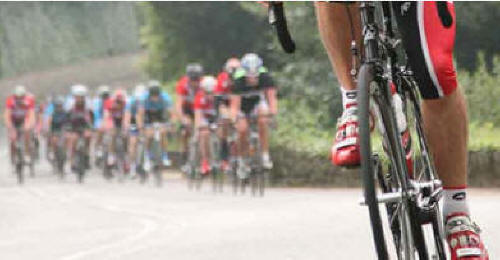
When's the best time to attack?
There are many, many opportunities to attack
in a race here's just a few of them;
▼ As the previous attack is brought back
▼ As everyone slows in the mid-race lull
▼ Just after a Prime (pronounced preem)
▼ When everyone's fuelling up
▼ Fifty metres before the top of a climb
▼ Out of a tight corner
▼ When everyone's watching everyone else
There we are, a not too comprehensive magnificent seven. There are many, many, many more examples and over the course of your cycling career they will all make themselves known to you. Just make sure you're paying attention, recognise the situation and grasp the opportunity before someone else does.
The Springboard
The classic springboard; one of the obvious ones! Which is why you need to be on the look out for
the counter-attack and sucker punch every time a race comes back
together.
Often, immediately an attack is brought back, a rider from a strong team will go up the road and force others to take up the chase.
He will do everything he can to stay away and drag the chase out for as long as he can, tiring out as many chasers as he can. Then, just as he's brought back, two of his team mates will go up the road. Our hare then abandons or sits at the back of the laughing group waiting to take the bunch sprint.
Your mission is to be on the back of those two riders as they go up the road. Because their team, and hopefully yours, will not be part of any organised chase and may even disrupt any attempts of an organisation taking place.
Also, those that have previously been chasing will be a bit miffed at getting worked over again and will probably have a bit of a sulk. This break might just be able to stay away. Obviously, you're going to get worked over by the gruesome two-some, but at worst you'll come in third! So pay attention and be a player not the played.
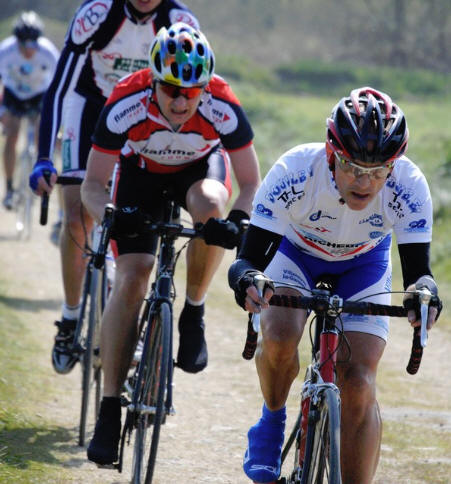
When someone goes, make sure you're with them
then do as much as you need for the break to survive ~ no more!
The Compression
You get a "compression" when the front of the group sits up
while the back of the group is still accelerating. This causes
people to brush their brakes and stop pedalling. Dangerous, but a
prime attacking opportunity. Especially in the last kilometres.
Unable to pedal, they're unable to change down a gear and will be over-geared for any acceleration they may have to make. Although it's a blinding opportunity to take a flyer, this is a dangerous part of the race on two counts.
Firstly; there's always someone who wants to turn around to see what's happening. I think I've made myself clear on this point before; NEVER, EVER, EVER, turn around in a race. The race is in front of you not behind you. This is the biggest failing I see in amateur racing. DON'T do it!
If you want to see what's happening behind, go to the back and look forward! Nothing good comes of looking back. Compression leads to closing gaps, looking back leads to an inability to see those gaps. If there isn't a "spotted" closure, someone ends up sitting on the floor, holding a saggy shoulder.
If you see a "backer" get around them and make sure they're no where near you. It's only a matter of time before they have someone down. Make sure it's not you.
Secondly; and this is where you come in, compressions are another attack launching opportunity. Especially after a Prime. As the points chasing protagonists sit up, their work seemingly done, you come from the front-middle, having sheltered in wheels up until this point, and launch an attack through, and off, the front. If it's a crit, and before a corner, so much the better.
There is usually a compression when everyone relaxes and fuels up after just brining back an attack, thinking the initial threat has gone. This is also a good time for you to go; it's hard for them to chase with a bottle in their hand and half a power bar in their mouth! People still manage to shout and swear though!
However, it isn't racing
etiquette, or the done thing, to attack through a feed zone. All
is fair in love, war and racing but there are codes of honour and this
is one of them. Don't do it. But watch out for less
scrupulous others attempting said manoeuvre!
The Power Surge
 Fifty
metres from the top of a climb is a good point to go. And if you
can take someone with you, as in the shot at the top of the page, that's
a double whammy.
Fifty
metres from the top of a climb is a good point to go. And if you
can take someone with you, as in the shot at the top of the page, that's
a double whammy.
It never hurts to take a friend along for a ride. If you share the workload over the top, to open a big gap as you hit the flat, while the others on the hill are still thinking about what to do, your work is almost complete.
Or you can go alone, if you know there's a descent you can nail on the other side; like in this shot over the crest of the Ghisallo in the Giro Lombardia Sportive. Surge the last 50 metres, push on over the crest and go straight to warp factor FTP.
Get over the top, get straight on it and get a gel down your throat on the way down. Don't let up until you get to the flat bit at the bottom and hopefully you have a gap you can hold to the finish. I actually managed this coming off the Poggio in the Milan San Remo Sportive!
Use the Terrain
The attacking corner option is also a good
one, especially in a crit, if you can get team mates to pitch in
and give you a buffer. As you head to the corner (or better still
combination of corners), line it out and build up a head of steam.
As you enter the first corner, your team mate gently brakes fifteen metres earlier than usual, no danger, no alert to the hapless followers behind. Little do they know what fate awaits them.
You? You don't brake at all. Nail it in the corner, give it a power surge (rather than a full blown sprint) and hang on for dear life as your bike drifts wide, just this side of staying right way up. Whatever you do, don't go down. By staying in the saddle you don't alert the others that you're attempting a breakaway.
Team mates, "soft tap" through the corner (the riders behind are watching them not you and it's too late to react), you surge out of the corner and subsequent corners, then go straight to threshold wattage. Before you know it, you've got a thirty metre lead, other teams are prevaricating/organising/faffing about, while your team mates are blocking/sitting in/deciding how to spend the winnings. Job done.
Building a Jump
If you're going to be attacking and jumping
all over the place in race then you'd better do something about honing
your skills in training.
Riding around with a chain gang or club run won't give you what you're after if you want to be the Jacky Durand of your club. The legendry nutter of the nineties, won the Tour of Flanders with a TWO HUNDRED AND SEVENTEEN KILOMETRE breakaway. Think on...
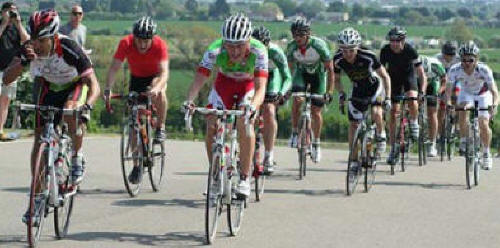
If you want to be extra cool, and attack
one-handed over a climb, like
Ossie Assem in the
shot above, then you need to build a jump. You can see from the
picture that Ossie isn't the biggest of riders but he's putting some
powerful racers in to serious difficulty at the top of the crest. All while he's removing his Oakleys to get a better view of the damage
he's causing!!! How cool is that?
If you want to escape the pack you need to build a lightening, explosive and powerful attack. There's no use taking 30 seconds to build up to a 800 watt power surge, while everyone is sitting on your wheel, waiting for you to back off so they can attack you. Check out the training drills and choose your pain-fest of choice.
Get a punchy gear, get on top of it quickly and get those legs spinning before anyone realises what's happening. Then get sat down, clunk it up a gear or two and get on the pedals cranking out threshold wattage as soon as you can. It should all be done and dusted in around five or six seconds. Don't give anyone a chance to grab your wheel. If you want to practice it in training; here's what you do...
Your first key event of the season isn't the
first time to be practising this. Once the season has started,
every other training session you do needs to have simulated race attacks
in them. If you haven't time to train, because your racing, do
them in your preparation races. Just make sure you do them and do
them often.
Rules of The Break
When, not if, you get in a break there are a
few golden rules you need to observe. Here's a few of them...
Keep quiet; anyone who knows me will testify this is the rule I always break! Don't shout at others, keep a low profile and do as much work as the person who is doing the least. The ability to hide in the break can not be underestimated as a race winning tool.
Get a through and off going; lead by example, and do everything you can to shelter from the wind. If need be get an echelon running and make sure it changes when the wind direction changes. You'll be surprised at how often it doesn't.
If someone else assumes the mantle of "break-organiser" let them. Don't play the alpha male, let them do it, just shrink in to the background and play dumb.
Eat, little and often; and always when you are at the back; never let anyone catch you eating. They'll attack you!
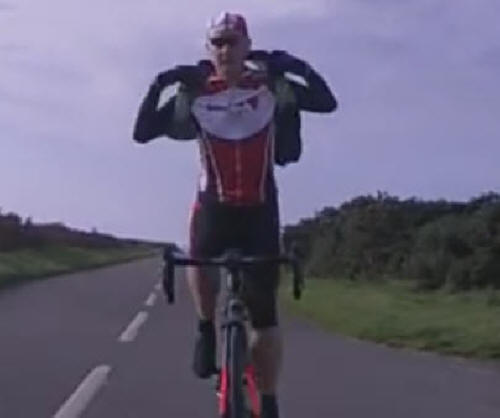
The same goes for putting on or taking off a
gilet
never do it where people can see you, they'll attack!
Pay attention; just because you're in a break doesn't mean your job's done. Go back to the top of the page and start reading again. You need to pay attention at all times. It may be a smaller group but the dangers are just as real, if not more so.
Remember, these are the clever ones that got away. You ain't going to fool these as easily as the others.
The Flamme Rouge
Once you get to the final kilometre it all
starts to get really cagey. All of a sudden, especially in local
races and European sportives, you'll find riders swamping to the front
of the group that you haven't seen since signing on.
Hold your nerve, hold the wheel and hold your position. Don't do anything dangerous but assert your right to be there and never take your eyes off the wheel ahead, or give it up.
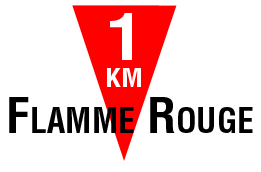
You're in a group of breakaway experts. If these people were sprinters they'd be back in the bunch waiting for the gallop. They're not, so pay attention.
At some point, someone will take a flyer. Unlike the pro's who have someone screaming in their ear about what to do and when to do it, you need to think for yourself.
So, someone's, cracked early and taken a flyer. What do you do?
Take a look at the rider who's gone up the road; does he look strong, are his shoulders all over the place, is he pedalling squares, does he look like a stayer or are they the panic throes of a desperate man? Get ready for someone else to panic and start the chase. Because it's not going to be you.
The first person to bring him back will be the first person to lose. If no one looks like they're going to go, offer encouragement. If you're in the middle, shout "hup-hup" (it's a universal language!) as it may provoke someone in front to jump thinking they can grab a wheel as the mystery attacker goes from behind them. A chase needs to go and it needs to go quickly. Nervous riders chase.
While everyone's deciding what to do our intrepid gambler might just stay away. Of the almost 100 European sportives I've done over the last ten years, I've felt strong/confident/stupid enough to take a flyer five times. I've stayed away for four of them. It's that rare an occasion but the success results are high... Especially when no one knows you!
I'm a sprinter (of sorts) but in those events I saw stronger sprinters around me so had to adapt. In five percent of the events it's been an effective solution, with an 80% success rate. If you're not a sprinter surely it's better to have a five percent gamble on a successful attack, rather than a 100% chance of a sprint failure?
If you go, go and don't look back. Ignore everything your head and legs are telling you. In the immortal words of Jens Voigt "Shut up damn legs!" If you want to see how this feels in training and to have a chance of succeeding in your race efforts, you need to try mixing Drop Intervals with 60 second Killers in to your programme.
Going off the front and hoping isn't good. The strap line for the business and management development programmes I use to design was "Hope is not a strategy". It's the same for attacks in bike races; who'd of thought it!
And if you do get away with a mate you can always attack each other in the final 100 meters! Chris Stephens and Andrew Perree, having attacked their group on the uphill climb to the finish, battle out the last 75 metres of the 2011 Marc Gomez.
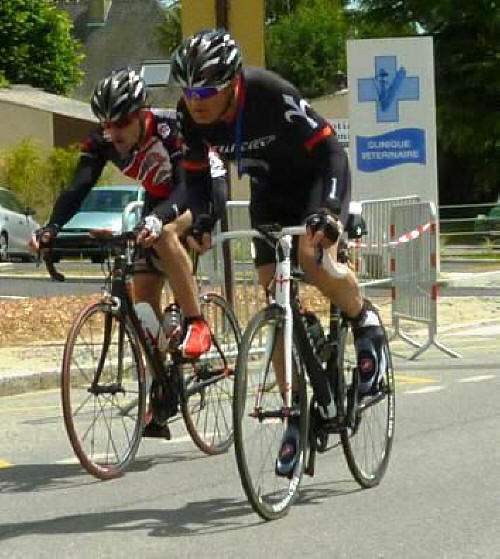
Andrew launches his attack as the nonchalant
Chris remains seated,
as Andrew sat down Chris stood up, game over...
And the lesson we learnt here was, even your best mate will attack you in the final hundred meters!. So pay attention; always!
The Message
As with chasing a break, the same message applies
for escaping. There are three types of people in this
world...
I hope the above message needs no further clarification.▼ Those that let things happen
▼ Those that makes things happen and
▼ Those that say "What happened?"
What doesn't kill you makes you stronger, so attack and if you're bought back so what? Attack again. It's better to be an active knight within your chosen event than a passive pawn. When you sit in the bunch you learn something about other people. When you attack you learn a whole lot more about yourself.
ost important of all, stay near the front. It's very rare a breakaway goes off the back; although I have been known to try it once or twice! One day I'll do a factsheet on my specialist subject; going out the back (with style).
Be brave, have a go and if you're brought back, learn from the experience and put that knowledge in to having a go in your next event. You're a racer, so lets race!
Oh, and always pay particular attention in the last kilometres before the Saturday morning coffee stop. It's one of the most hotly contested chases of the season.
Until next time...







